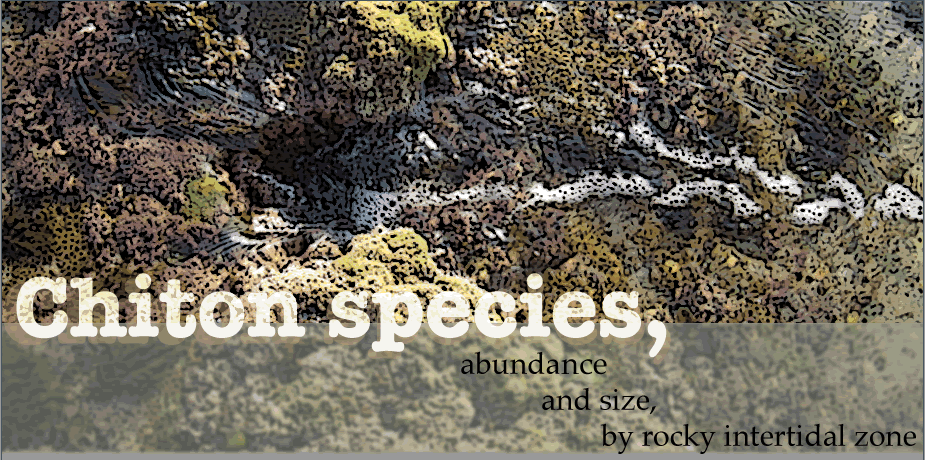 |
||||||||
 |
||||||||
|
Four identified species of chiton were found: green-stiped chiton (Chiton virgulatus), brown chiton (Chiton articulatus), black chiton (Chiton stokesii), (Kaas, et al 2006), and striped or "heath's" chiton (Stenoplax heathiana) (Burghardt, 1969). Chitons were found exclusively on basalt rocks. Different patterns were observed in the various rocky intertidal zones with respect to abundance, size, and species. On average, more chitons were found per rock in lower/middle Zone III. Chitons were largest in lower Zone III and high Zone IV. Low Zone III also contained the most chiton species. Green striped chiton (Chiton virgulatus) was the most prevalent species and was the most dominant species throughout high and low Zone III. Black and green striped chitons were found in low Zone III. One brown chiton was found in Zone IV. Striped chitons were found in middle Zone II. Rock size and chiton size and abudance also shared a pattern. There was a positive relationship between length of chitons and rock size. Rock size and abundance of chitons per rock were inversely proportional. The initial purpose of this study was to determine species abundance with respect to rock type, either basalt or coquina. It was predicted that different species of chiton would prefer certain rock types based on their color. For example, heath's chiton (Stenoplax heathiana) would prefer coquina because the light color of the rock would provide excellent camouflage for the animal. Darker species, such as black chiton (Chiton stokesii), would prefer basalt rock for the same reason. Because data was not collected for coquina rocks, such as pattern cannot be determined. However, the sample size for heath's chiton was small (n=1) which indicates the species is rare, at least on Station Beach, Puerto Penasco. We speculate that darker species may have an advantage, if all chiton species prefer basalt rocks which provide adequate camouflage for dark species and poor camouflage for light species. If such an advantage exists then it may explain why dark species are common on station beach and why heath's chiton (Stenoplax heathiana) are rare. Little research has been done on chiton (polypochophora) distribution in the Gulf of California. Studies in Costa Rica indicate chitons are most abundant in middle zones during high tide. Chiton distribution drastically increases in middle zones as compared to lower zones, closer to the ocean, and high zones, further from the ocean. Furthermore, species diversity of chiton followed a similar model. Chiton body size increased in densely populated zones (Joger, et al 2008). The results of our study yielded similar results. Perhaps, then, chitons share important mutualistic relationships with surrounding species if they tend to group in areas where resources are plentiful. Based on our results and knowledge of chiton distribution further studies may provide insight about chiton preferences. Resource availability may limit abundance of chiton species in various zones. Coquina rocks were observed to be densely populated with tunicates, green algae, tubeworms, snails, and hermit crabs. Chitons from our sample size were not found on coqunia rocks, Basalt rocks tended to have less species diversity than coquina rocks, yet, were suitable hosts for chitons. We considered that chitons may also tend towards areas with less competition for resources. However, relationships between species diversity and chiton abundance was not examined in our study. Furthermore, the results of our study indicated that smaller chitons tended to be found in groups and larger chitons tended to be found solitary. Perhaps, small chitons must group together for protection, whereas large chitons are solitary in order to avoid competition as they would need more food resources. In general, chitons were found in certain zones that we labeled as "chiton rich environments". It seems that chitons are all found in the same vicinity of each other but are almost nonexistent in where chitons are difficult to find. More studies need to be conducted on chiton grouping behaviors. Some of the results of this experiment may be confounded by experimental errors. During the second morning of experimentation the experimental method called for starting at low tide, but the experiment began at middle tide. As a result, some data may be missing as the tide came in. A GPS unit was not used to determine the area in which experimental data was gathered on the first night. Thus, the intended area to sample the next day was not immediately determined. Finally, during night observations chiton species were often indistinguishable due to available lighting and resources of known chiton species, C. Stokesii, C. articulatus, and C. virgulatus are similar in appearance. Future experiments would require an extended amount of time in Puerto Penasco and intensive planning in order to obtain accurate and reliable data.   |
||||||||